Study of Combined Multi-Point Constraint Multi-Scale Modeling Strategy for Ultra-High-Performance Steel Fiber-Reinforced Concrete Structures
Abstract
:1. Introduction
2. Multi-Scale Modeling Strategy—Material Models
2.1. Calibrated Concrete Damage Plasticity (CDP) Model
2.2. Validation of the Model
2.2.1. Test Specimens
2.2.2. Finite Element Analysis (FEA) Model
2.2.3. Results of FEA Simulation and Test
3. Multi-Scale Modeling Strategy—Interface Connection
3.1. Combined Multi-Point Constraint (CMPC) of Multi-Scale Model
3.1.1. Combine Multi-Point Constraint Relations
3.1.2. Constraint of the Interface in Tangential Direction
3.1.3. Constraint of the Interface in Rotational Direction
3.2. CMPC Equations of Multi-Scale Connection of Beam-Solid Element
4. Multi-Scale Models of Ultra-High-Performance Steel Fiber-Reinforced Concrete
4.1. Multi-Scale Models Built-Up
4.2. Unidirectional Load Cases
4.2.1. Axial Compression Load Case
4.2.2. Bending Load Case
4.2.3. Shear Load Case
4.3. Multidirectional Composite Load Case
5. Conclusions
- The applicability of concrete damage plasticity (CDP) model in finite element software ABAQUS to UHPFRC was verified according to the four-point bending test results of reinforced UHPFRC beams. The simulation results show that the calibrated CDP model used in the multi-scale modeling strategy in this study can accurately and effectively predict the load-displacement curve and plastic damage distribution of UHPFRC components.
- A novel combined multi-point constraint method was established by the simultaneous equations of the displacement coordination equation and energy balance equation in different directions of the interface. The CMPC method eliminates the problem of the tangential over-constraint of displacement coordination equation at the interface and avoids stress iteration of energy balance equation in the plastic stage. The multi-point constraint equations conform to the transfer relations of displacement and stress between the interface nodes.
- The expression of the constraint equations of the multi-scale connection of beam-solid element by CMPC method was derived. The multi-scale model of the reinforced UHPFRC component was established in ABAQUS with this expression and the calibrated CDP model. The axial compression load case, bending load case, shear load case, and multidirectional composite load case are analyzed.
- The simulation results of the multi-scale model under each load case show that the multi-scale model established by the CMPC method can significantly reduce the number of model elements and improve the calculation efficiency. The CMPC models have good simulation accuracy in the analysis of each load case compared with the displacement coordination model and the energy balance model. In the strain-hardening stage of UHPFRC, the CMPC method can still accurately simulate the stress distribution and damage distribution of the connection interface. It can be applied to multi-scale finite element analysis of UHPFRC structures with accuracy and efficiency.
Author Contributions
Funding
Conflicts of Interest
Appendix A
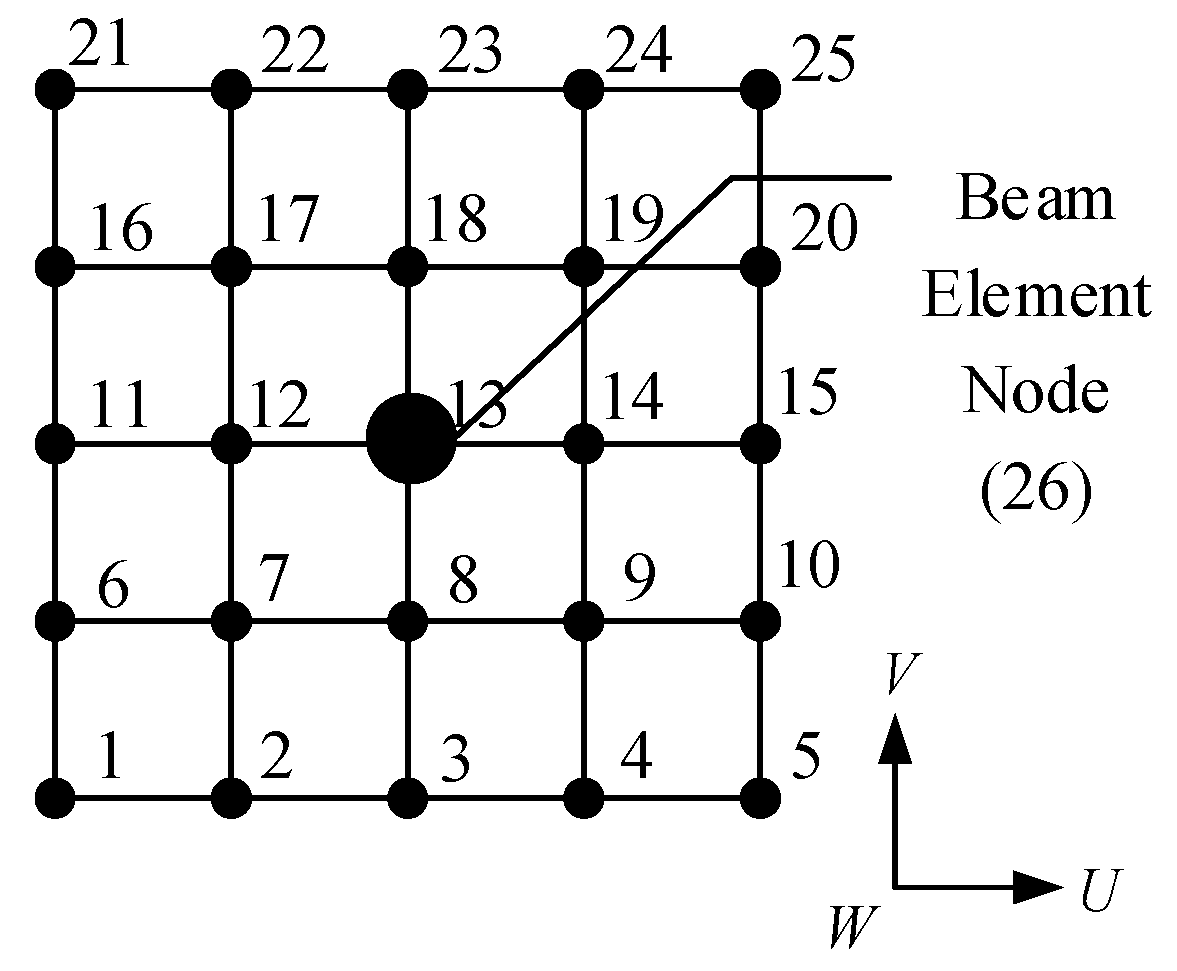
References
- De Larrard, F.; Sedran, T. Optimization of ultra-high-performance concrete by the use of a packing model. Cem. Concr. Res. 1994, 24, 997–1009. [Google Scholar] [CrossRef]
- Rossi, P.; Arca, A.; Parant, E.; Fakhri, P. Bending and compressive behaviours of a new cement composite. Cem. Concr. Res. 2005, 35, 27–33. [Google Scholar] [CrossRef]
- Graybeal, B. Material Property Characterization of Ultra-High Performance Concrete; No. Fhwa-Hrt-06-103; Federal Highway Administration: Washington, DC, USA, 2006; pp. 1–176.
- Habel, K.; Viviani, M.; Denarié, E.; Brühwiler, E. Development of the mechanical properties of an Ultra-High Performance Fiber Reinforced Concrete (UHPFRC). Cem. Concr. Res. 2006, 36, 1362–1370. [Google Scholar] [CrossRef]
- Magureanu, C.; Sosa, I.; Negrutiu, C.; Heghes, B. Mechanical properties and durability of ultra-high-performance concrete. ACI Mater. J. 2012, 109, 177–184. [Google Scholar]
- Wille, K.; Naaman, A.E.; El-Tawil, S. Optimizing ultra-high-performance fiber-reinforced concrete. Concr. Int. 2011, 33, 35–41. [Google Scholar]
- Triantafillou, T.C.; Papanicolaou, C.G. Shear strengthening of reinforced concrete members with textile reinforced mortar (TRM) jackets. Mater. Struct. Mater. Constr. 2006, 39, 93–103. [Google Scholar] [CrossRef]
- Ortlepp, R.; Hampel, U.; Curbach, M. A new approach for evaluating bond capacity of TRC strengthening. Cem. Concr. Compos. 2006, 28, 589–597. [Google Scholar] [CrossRef]
- Si Larbi, A.; Contamine, R.; Ferrier, E.; Hamelin, P. Shear strengthening of RC beams with textile reinforced concrete (TRC) plate. Constr. Build. Mater. 2010, 24, 1928–1936. [Google Scholar] [CrossRef]
- Parra-Montesinos, G.J. High-performance fiber-reinforced cement composites: An alternative for seismic design of structures. ACI Struct. J. 2005, 102, 668–675. [Google Scholar]
- Canbolat, B.A.; Parra-Montesinos, G.J.; Wight, J.K. Experimental study on seismic behavior of high-performance fiber-reinforced cement composite coupling beams. ACI Struct. J. 2005, 102, 159–166. [Google Scholar]
- Barnett, S.J.; Lataste, J.F.; Parry, T.; Millard, S.G.; Soutsos, M.N. Assessment of fibre orientation in ultra high performance fibre reinforced concrete and its effect on flexural strength. Mater. Struct. Mater. Constr. 2010, 43, 1009–1023. [Google Scholar] [CrossRef]
- Wille, K.; Kim, D.J.; Naaman, A.E. Strain-hardening UHP-FRC with low fiber contents. Mater. Struct. Mater. Constr. 2011, 44, 583–598. [Google Scholar] [CrossRef]
- Kim, D.J.; Park, S.H.; Ryu, G.S.; Koh, K.T. Comparative flexural behavior of Hybrid Ultra High Performance Fiber Reinforced Concrete with different macro fibers. Constr. Build. Mater. 2011, 25, 4144–4155. [Google Scholar] [CrossRef]
- Ryu, G.S.; Kim, S.H.; Ahn, G.H.; Koh, K.T. Evaluation of the direct tensile behavioral characteristics of UHPC using twisted steel fibers. In Advanced Materials Research; Inner Mongolia University of Technology, Korea Maritime University and Queensland University of Technology: Guangzhou, China, 2013; Volume 602–604, pp. 96–101. [Google Scholar]
- Yoo, D.Y.; Lee, J.H.; Yoon, Y.S. Effect of fiber content on mechanical and fracture properties of ultra high performance fiber reinforced cementitious composites. Compos. Struct. 2013, 106, 742–753. [Google Scholar] [CrossRef]
- Yoo, D.Y.; Kang, S.T.; Yoon, Y.S. Effect of fiber length and placement method on flexural behavior, tension-softening curve, and fiber distribution characteristics of UHPFRC. Constr. Build. Mater. 2014, 64, 67–81. [Google Scholar] [CrossRef]
- Yoo, D.Y.; Shin, H.O.; Yang, J.M.; Yoon, Y.S. Material and bond properties of ultra high performance fiber reinforced concrete with micro steel fibers. Compos. Part B Eng. 2014, 58, 122–133. [Google Scholar] [CrossRef]
- Choi, W.C.; Jung, K.Y.; Jang, S.J.; Yun, H.-D. The Influence of Steel Fiber Tensile Strengths and Aspect Ratios on the Fracture Properties of High-Strength Concrete. Materials 2019, 12, 2105. [Google Scholar] [CrossRef] [Green Version]
- Graybeal, B.A. Flexural behavior of an ultrahigh-performance concrete I-girder. J. Bridge Eng. 2008, 13, 602–610. [Google Scholar] [CrossRef]
- Chen, L.; Graybeal, B. Modeling Structural Performance of 2nd Generation Ultra-High Performance Concrete Pi-Girders. J. Bridge Eng. 2012, 17, 634–643. [Google Scholar] [CrossRef]
- Yang, I.H.; Joh, C.; Kim, B.S. Flexural strength of large-scale ultra high performance concrete prestressed T-beams. Can. J. Civ. Eng. 2011, 38, 1185–1195. [Google Scholar] [CrossRef]
- Yoo, D.Y.; Yoon, Y.S. Structural performance of ultra-high-performance concrete beams with different steel fibers. Eng. Struct. 2015, 102, 409–423. [Google Scholar] [CrossRef]
- Yang, I.H.; Joh, C.; Kim, B.S. Structural behavior of ultra high performance concrete beams subjected to bending. Eng. Struct. 2010, 32, 3478–3487. [Google Scholar] [CrossRef]
- Xia, J.; Mackie, K.R.; Saleem, M.A.; Mirmiran, A. Shear failure analysis on ultra-high performance concrete beams reinforced with high strength steel. Eng. Struct. 2011, 33, 3597–3609. [Google Scholar] [CrossRef]
- Yoo, D.Y.; Banthia, N.; Kim, S.W.; Yoon, Y.S. Response of ultra-high-performance fiber-reinforced concrete beams with continuous steel reinforcement subjected to low-velocity impact loading. Compos. Struct. 2015, 126, 233–245. [Google Scholar] [CrossRef]
- Astarlioglu, S.; Krauthammer, T. Response of normal-strength and ultra-high-performance fiber-reinforced concrete columns to idealized blast loads. Eng. Struct. 2014, 61, 1–12. [Google Scholar] [CrossRef]
- Wu, C.; Oehlers, D.J.; Rebentrost, M.; Leach, J.; Whittaker, A.S. Blast testing of ultra-high performance fibre and FRP-retrofitted concrete slabs. Eng. Struct. 2009, 31, 2060–2069. [Google Scholar] [CrossRef]
- Chen, J.F.; Chen, G.M.; Teng, J.G. Role of bond modelling in predicting the behaviour of RC beams shear-strengthened with FRP U-jackets, keynote. In Proceedings of the 9th International Symposium on Fibre Reinforced Polymer for Concrete Structures (FRPRCS9), Sydney, Australia, 15 July 2009. [Google Scholar]
- Li, S.Q.; Chen, J.F.; Bisby, L.A.; Hu, Y.M.; Teng, J.G. Strain efficiency of FRP jackets in FRP-confined concrete-filled circular steel tubes. Int. J. Struct. Stab. Dyn. 2012, 12, 75–94. [Google Scholar] [CrossRef]
- Chen, G.M.; Chen, J.F.; Teng, J.G. On the finite element modelling of RC beams shear-strengthened with FRP. Constr. Build. Mater. 2012, 32, 13–26. [Google Scholar] [CrossRef] [Green Version]
- Tysmans, T.; Wozniak, M.; Remy, O.; Vantomme, J. Finite element modelling of the biaxial behaviour of high-performance fibre-reinforced cement composites (HPFRCC) using Concrete Damaged Plasticity. Finite Elem. Anal. Des. 2015, 100, 47–53. [Google Scholar] [CrossRef]
- Mahmud, G.H.; Yang, Z.; Hassan, A.M.T. Experimental and numerical studies of size effects of Ultra High Performance Steel Fibre Reinforced Concrete (UHPFRC) beams. Constr. Build. Mater. 2013, 48, 1027–1034. [Google Scholar] [CrossRef]
- Singh, M.; Sheikh, A.H.; Mohamed Ali, M.S.; Visintin, P.; Griffith, M.C. Experimental and numerical study of the flexural behaviour of ultra-high performance fibre reinforced concrete beams. Constr. Build. Mater. 2017, 138, 12–25. [Google Scholar] [CrossRef]
- Fish, J.; Wagiman, A. Multiscale finite element method for a locally nonperiodic heterogeneous medium. Comput. Mech. 1993, 12, 164–180. [Google Scholar] [CrossRef]
- Fish, J.; Belsky, V. Multi-grid method for periodic heterogeneous media Part 2: Multiscale modeling and quality control in multidimensional case. Comput. Methods Appl. Mech. Eng. 1995, 126, 17–38. [Google Scholar] [CrossRef]
- Ghosh, S.; Lee, K.; Moorthy, S. Multiple scale analysis of heterogeneous elastic structures using homogenization theory and Voronoi cell finite element method. Int. J. Solids Struct. 1995, 32, 27–62. [Google Scholar] [CrossRef]
- Belytschko, T.; Xiao, S. Coupling Methods for Continuum Model with Molecular Model. Int. J. Multiscale Comput. Eng. 2003, 1, 115–126. [Google Scholar] [CrossRef] [Green Version]
- Kadowaki, H.; Liu, W. Bridging multi-scale method for localization problems. Comput. Meth. Appl. Mech. Eng. 2004, 193, 3267–3302. [Google Scholar] [CrossRef]
- Wellmann, C.; Wriggers, P. A two-scale model of granular materials. Comput. Methods Appl. Mech. Eng. 2012, 205. [Google Scholar] [CrossRef]
- McCune, R.; Armstrong, C.; Robinson, D. Mixed-dimensional coupling in finite models. Int. J. Numer. Methods Eng. 2000, 49, 725–750. [Google Scholar] [CrossRef]
- Ainsworth, M. Essential boundary conditions and multi-point constraints in finite element analysis. Comput. Methods Appl. Mech. Eng. 2001, 190, 6323–6339. [Google Scholar] [CrossRef]
- Yu, Y.; Chan, T.; Sun, Z.; Li, Z. Mixed-Dimensional Consistent Coupling by Multi-Point Constraint Equations for Efficient Multi-Scale Modeling. Adv. Struct. Eng. 2012, 15, 837–854. [Google Scholar] [CrossRef] [Green Version]
- Ren, X.; Li, J. Multi-scale based fracture and damage analysis of steel fiber reinforced concrete. Eng. Fail. Anal. 2013, 35, 253–261. [Google Scholar] [CrossRef]
- Lu, Z.H.; Zhao, Y.G. Empirical stress-strain model for unconfined high-strength concrete under uniaxial compression. J. Mater. Civ. Eng. 2010, 22, 1181–1186. [Google Scholar] [CrossRef]
- Birtel, V.; Mark, P. Parameterized finite element modelling of RC beam shear failure. In Proceedings of the ABAQUS Users’ Conference, Cambridge, UK, 23–25 May 2006; pp. 95–107. [Google Scholar]
- Hassan, A.M.T.; Jones, S.W.; Mahmud, G.H. Experimental test methods to determine the uniaxial tensile and compressive behaviour of ultra high performance fibre reinforced concrete (UHPFRC). Constr. Build. Mater. 2012, 37, 874–882. [Google Scholar] [CrossRef]
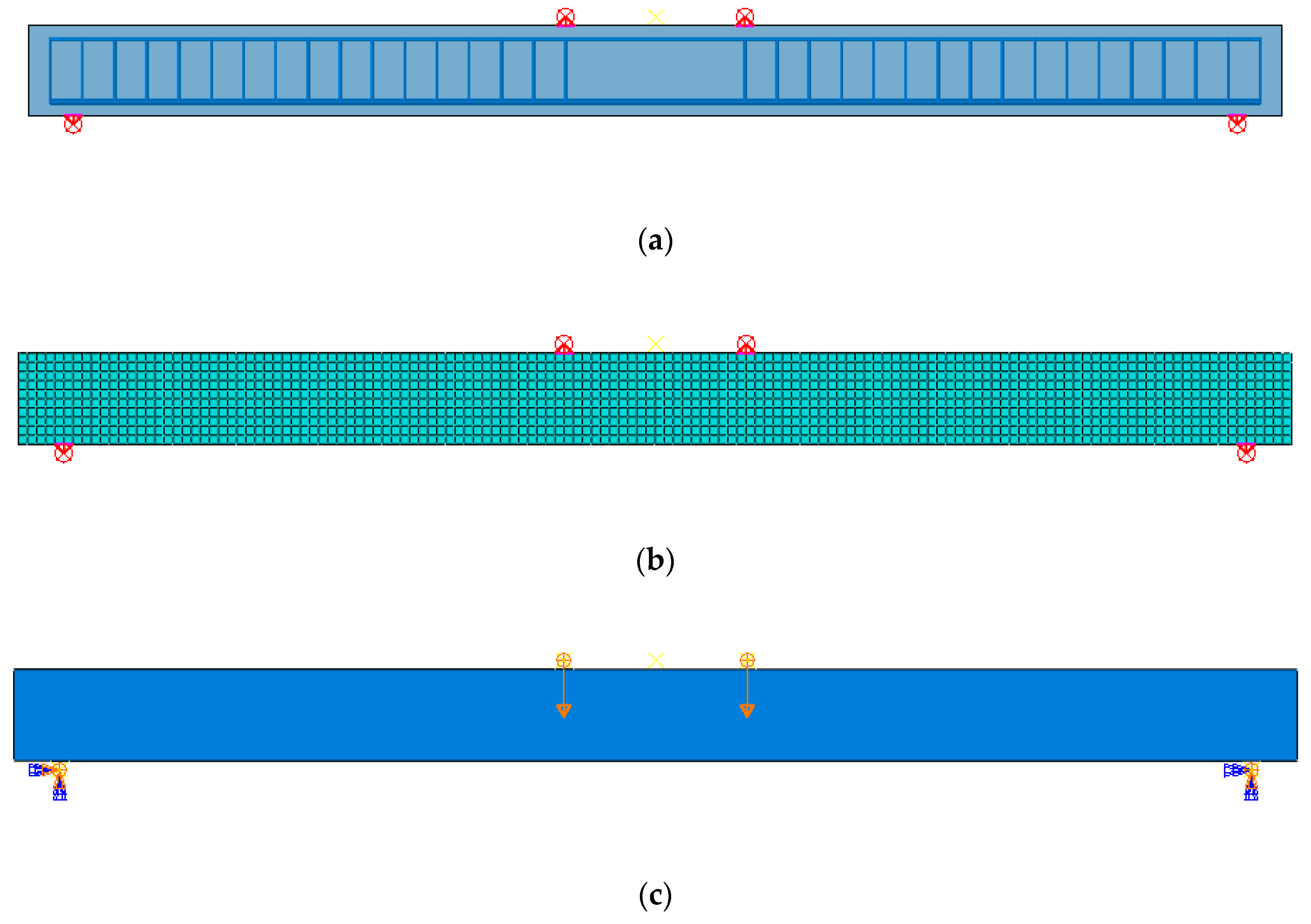
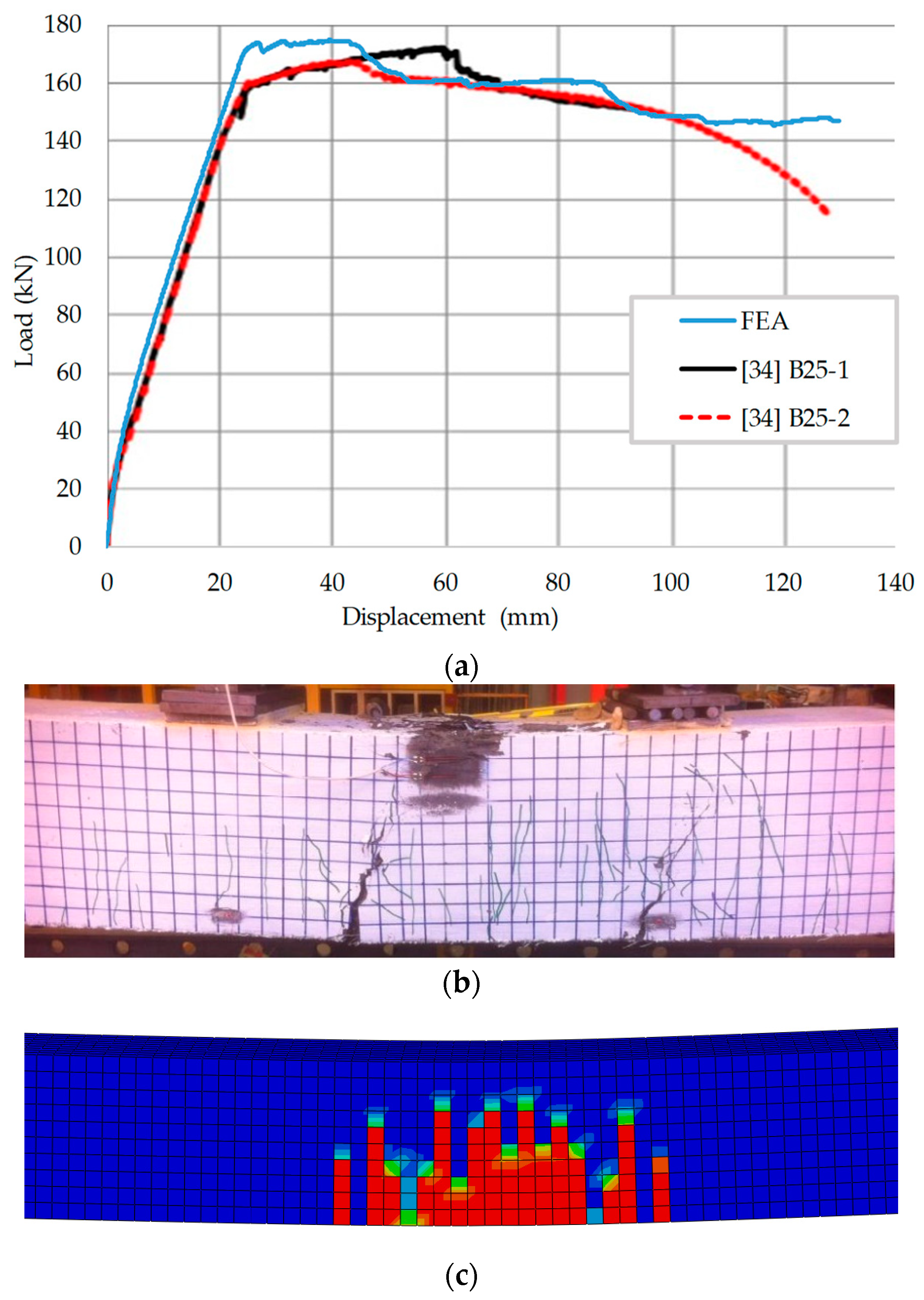
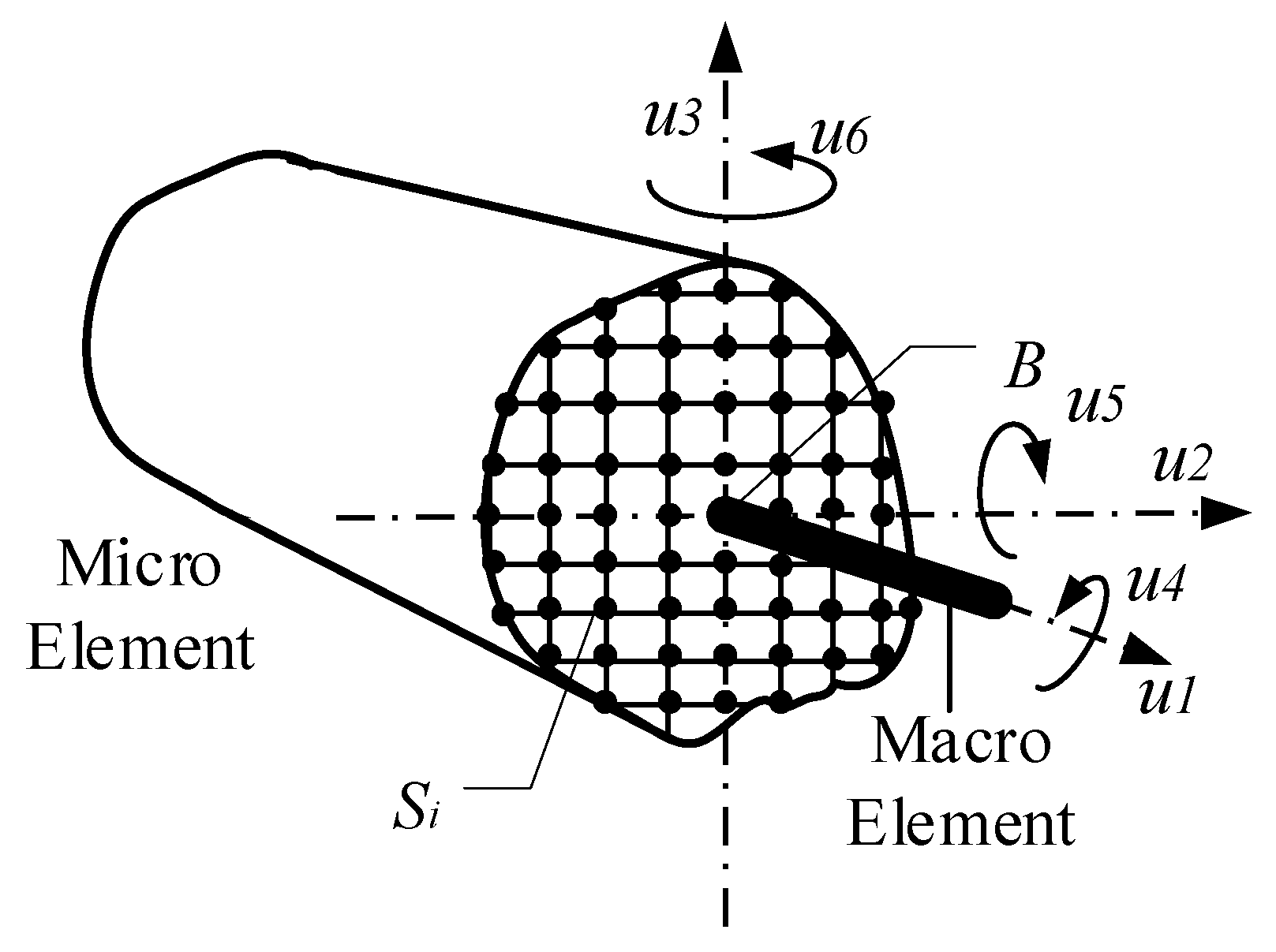
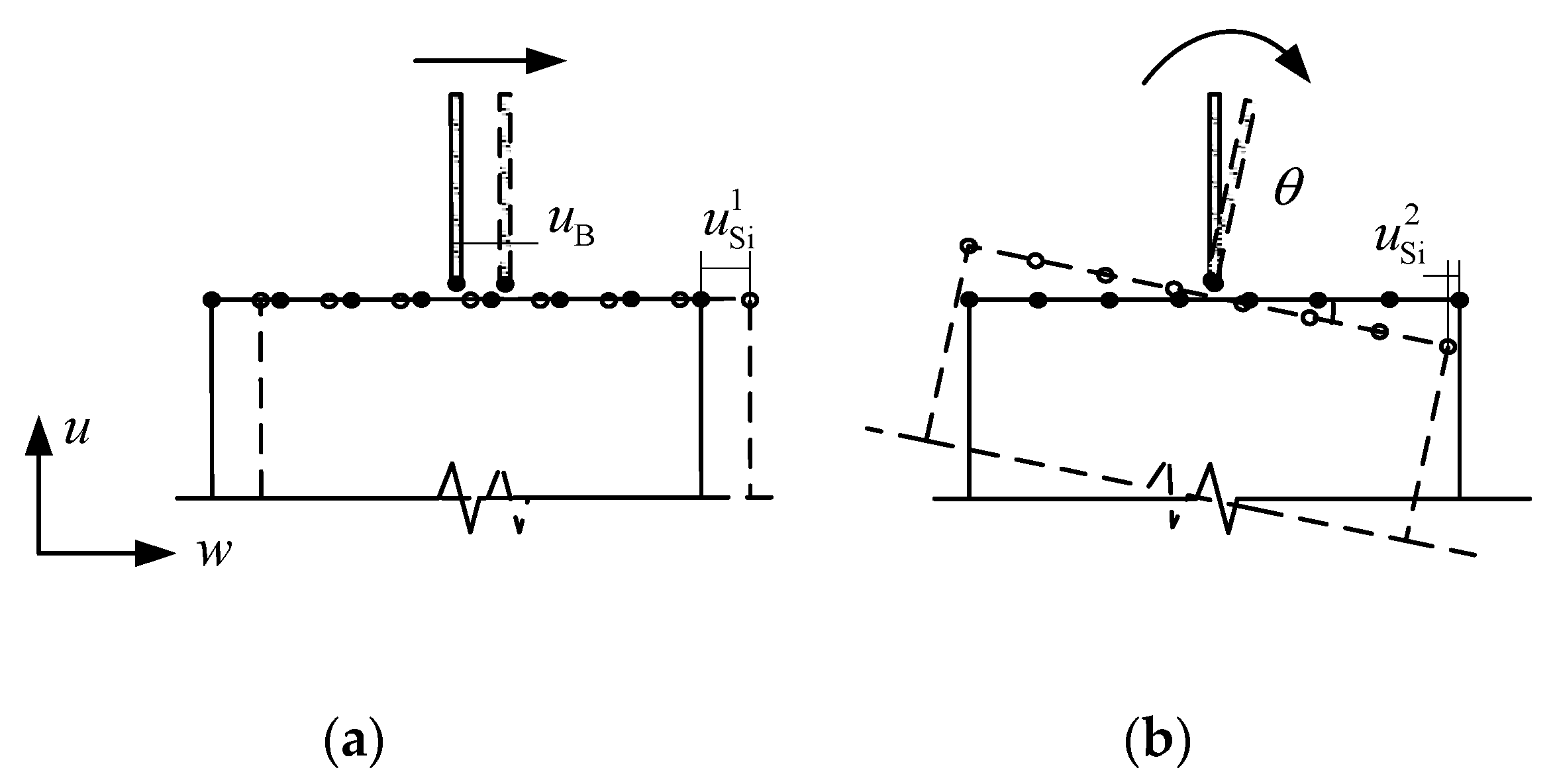

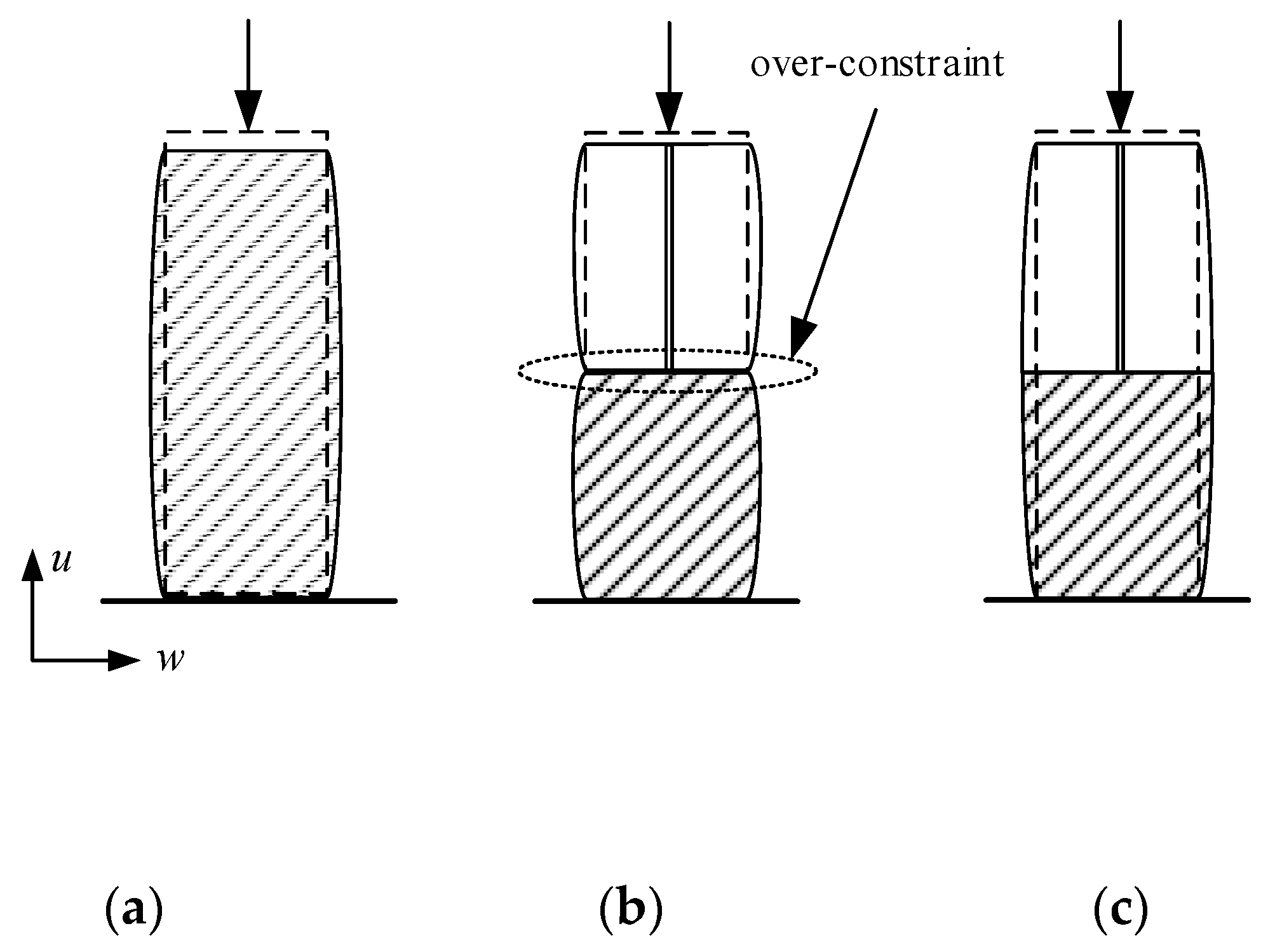

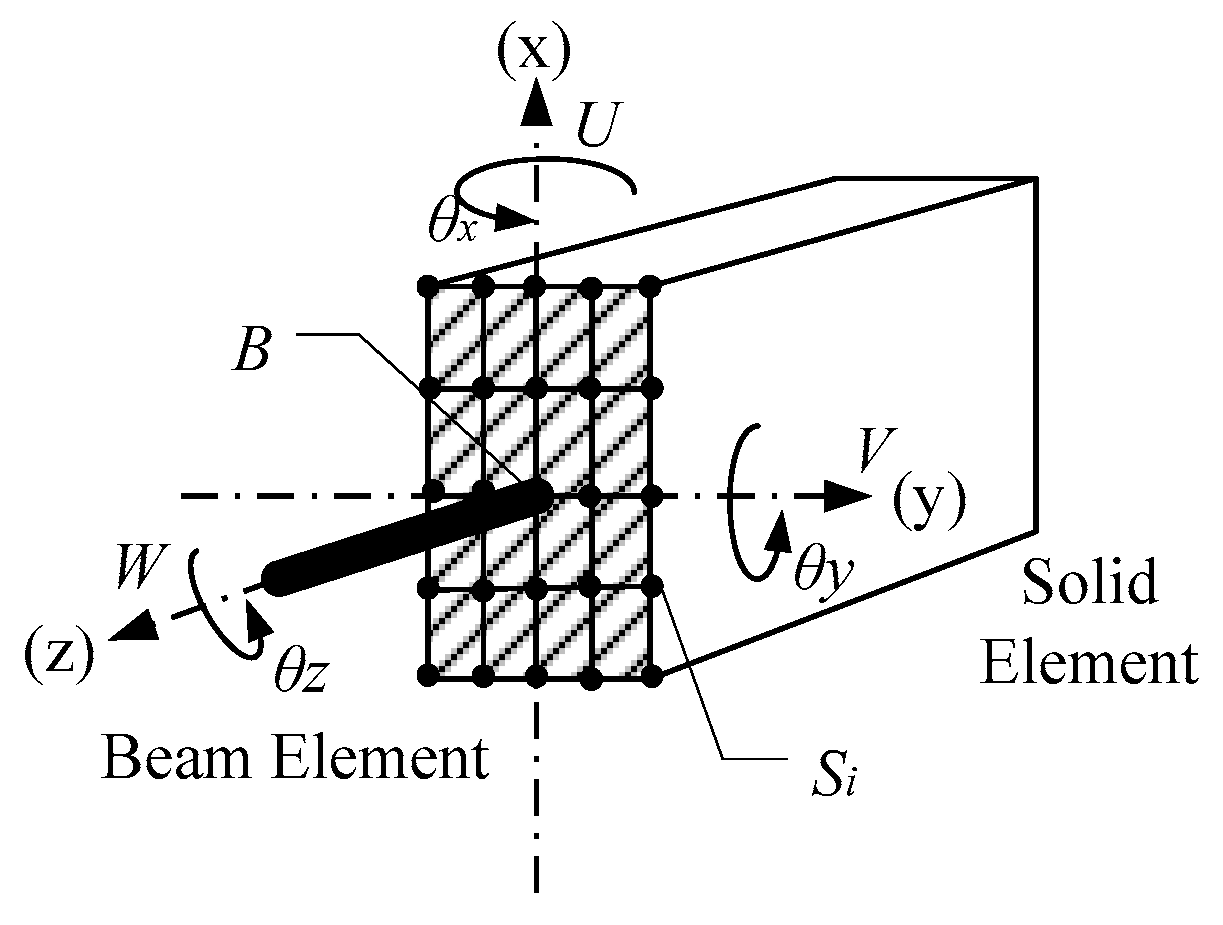
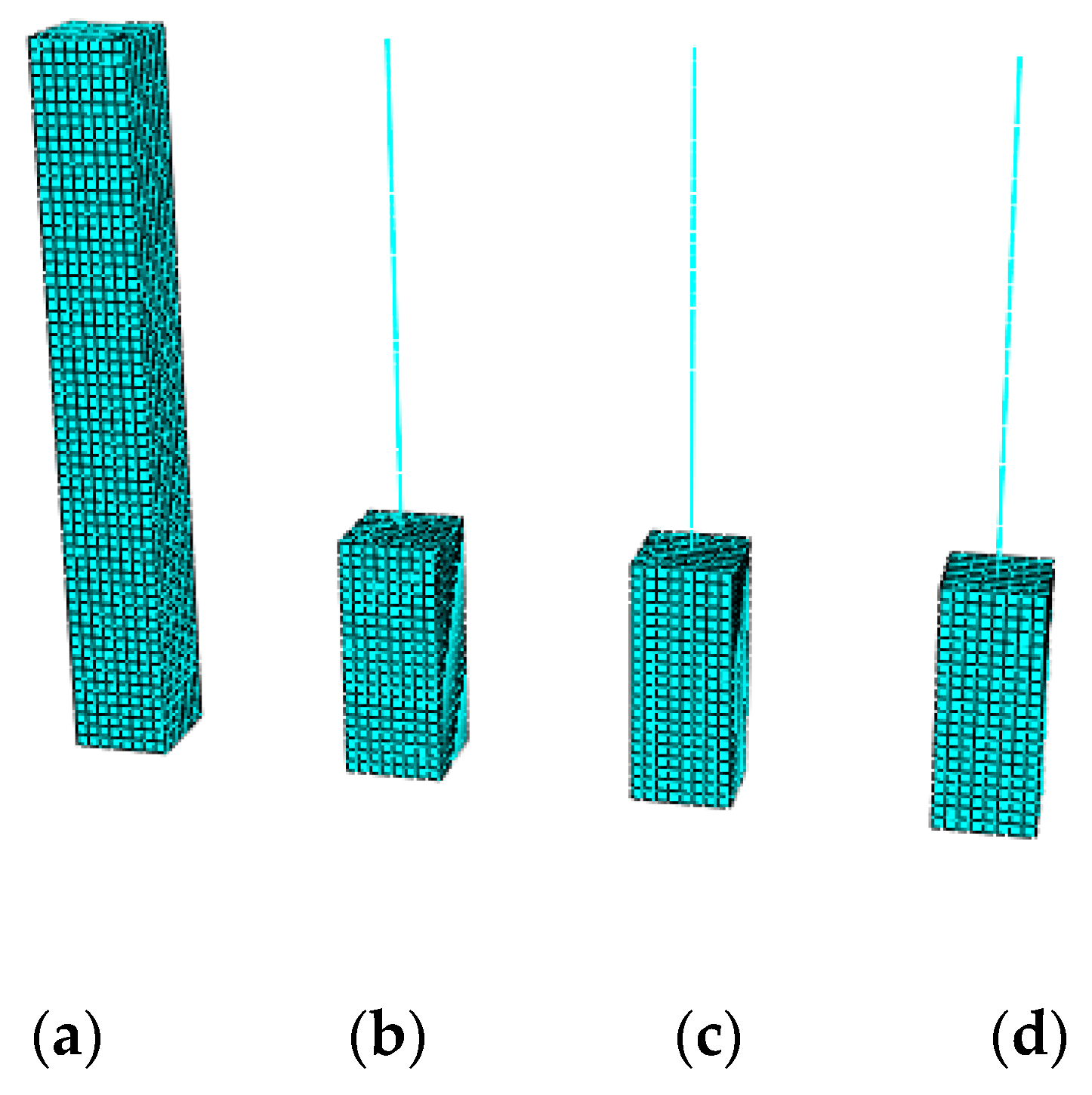
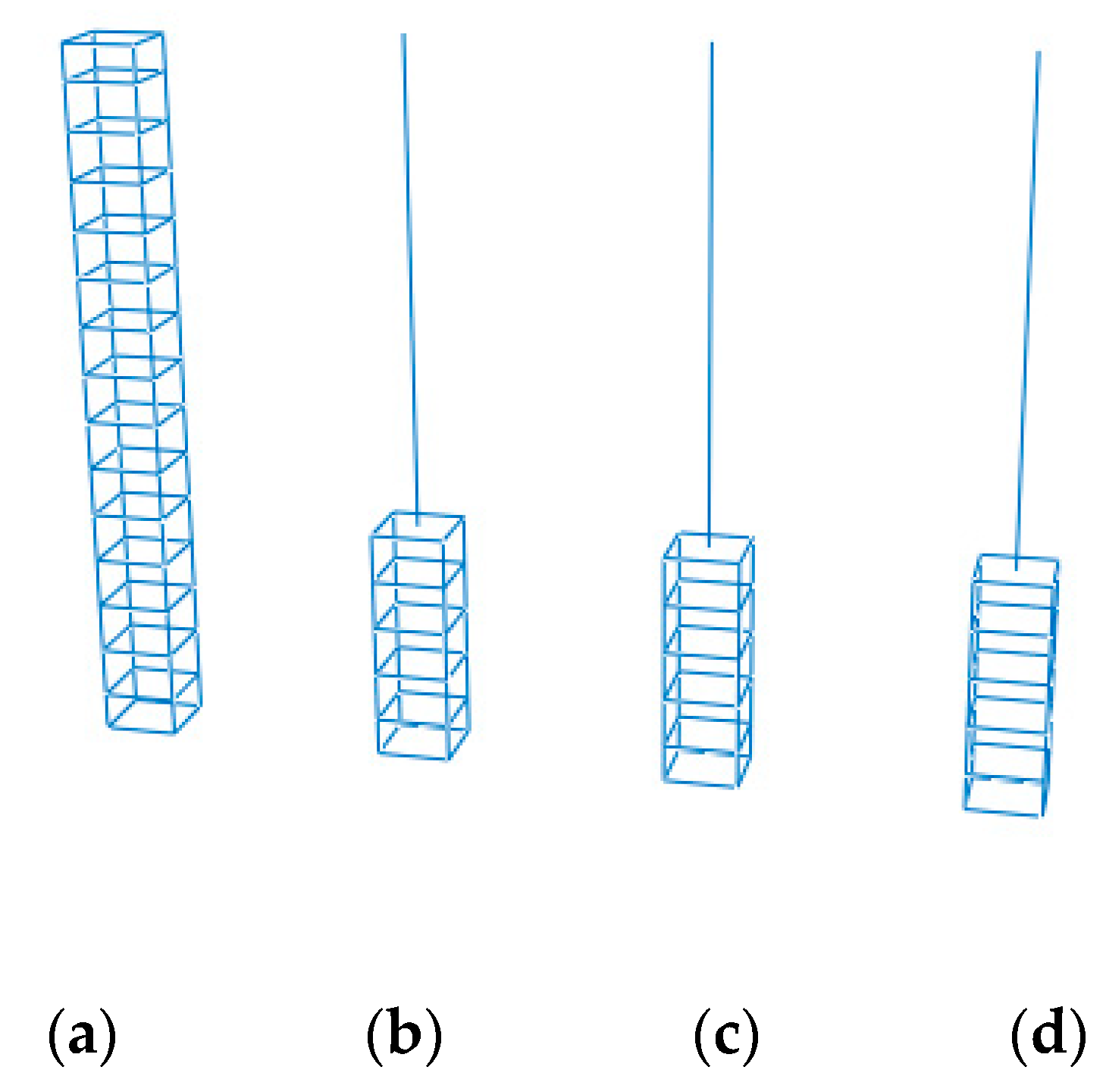

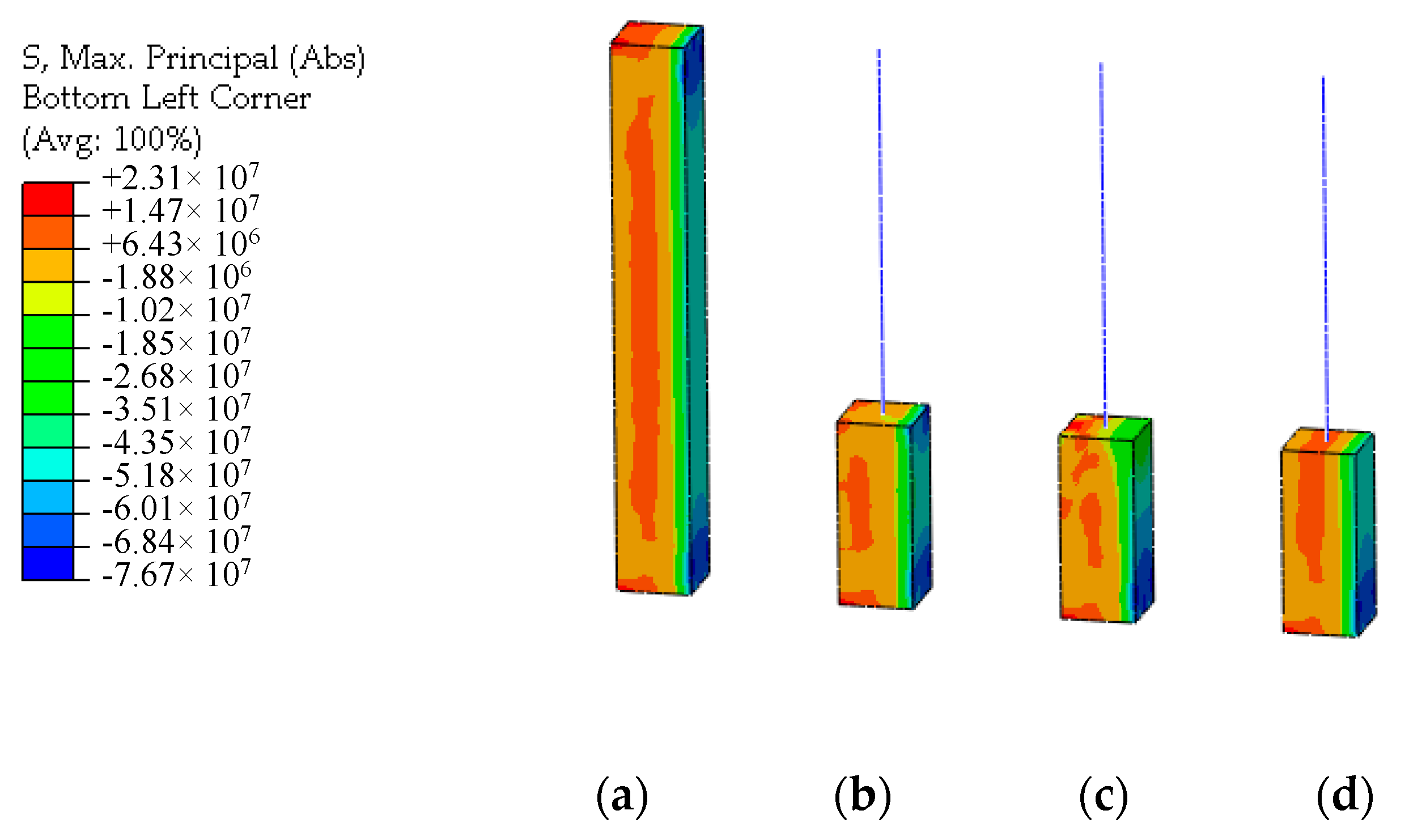

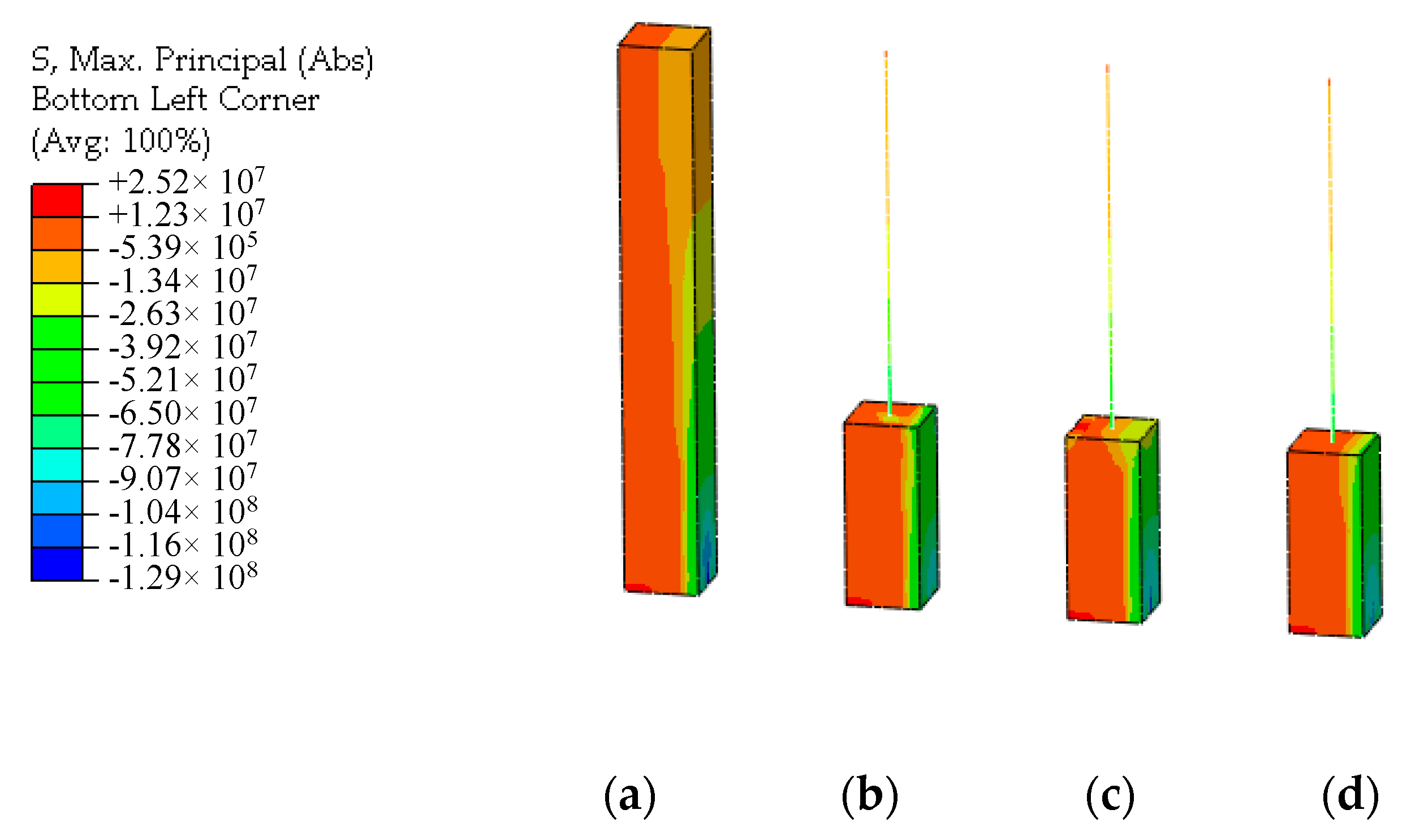
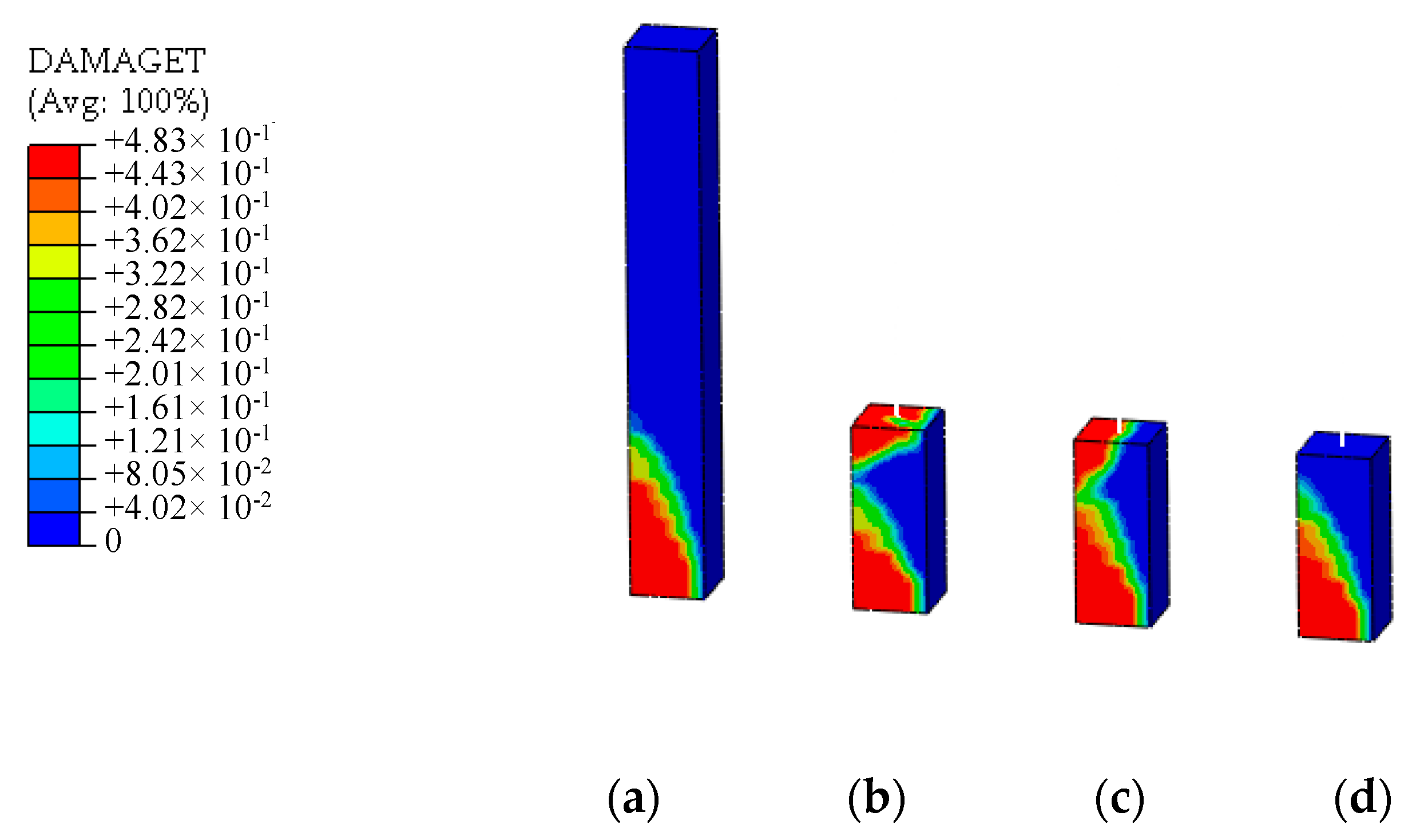
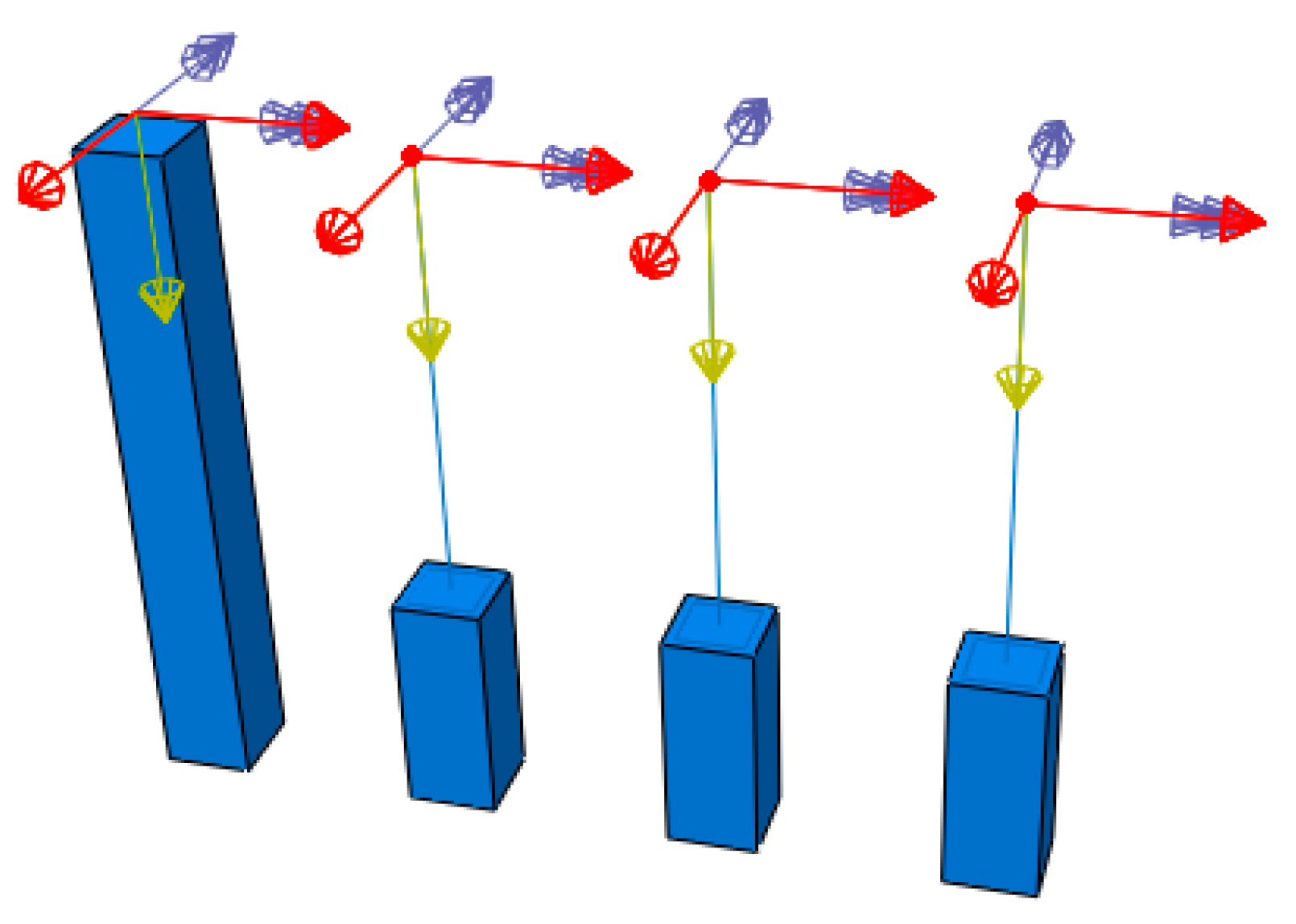
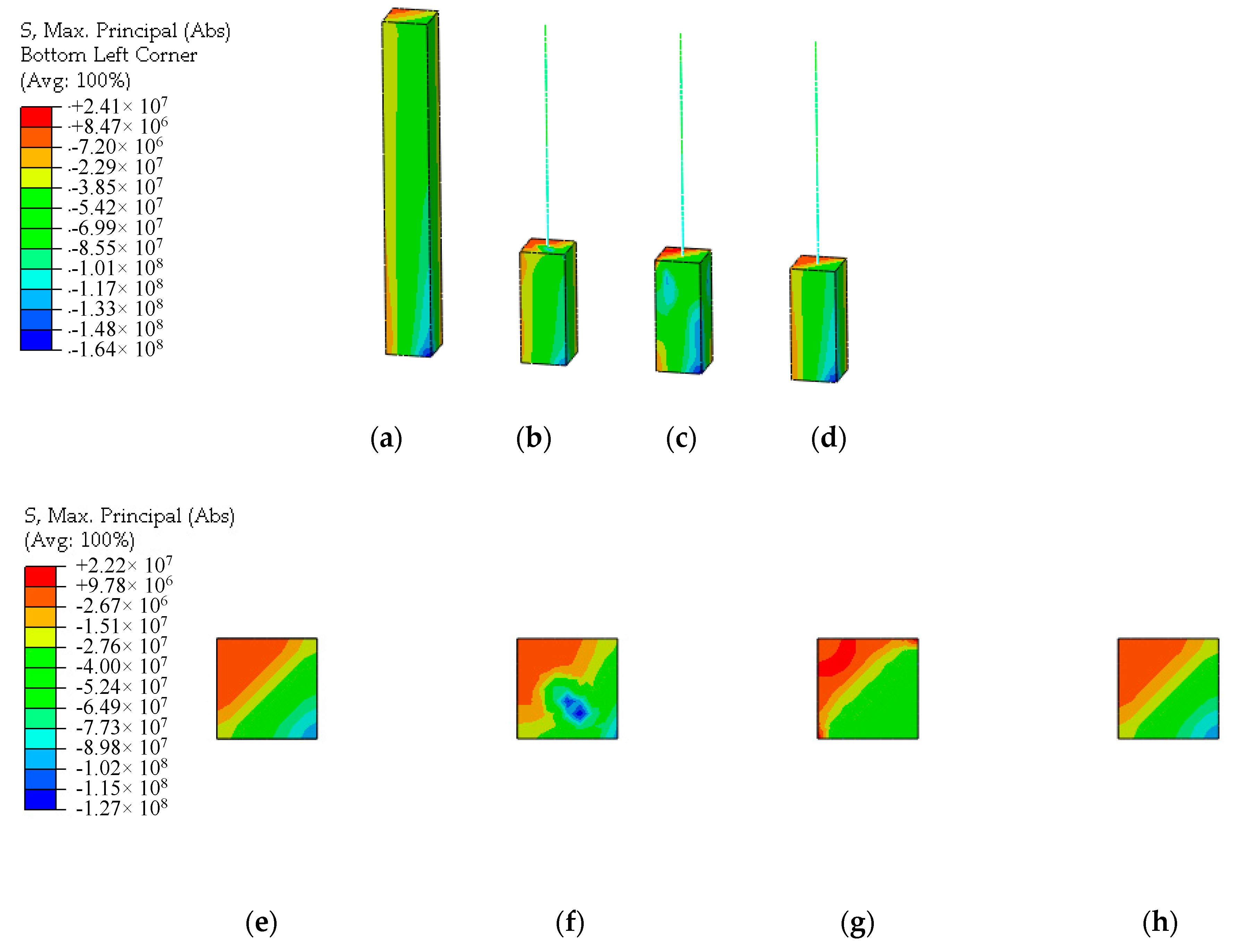
| Model Name | Young’s Modulus | Compressive Strength | Tension Yield Stress | Tension Peak Stress |
|---|---|---|---|---|
| CDP | 36.3 GPa | 140 MPa | 4.6 MPa | 5.8 MPa |
| Dilation angle | Eccentricity | fb0/fc0 | kc | Viscosity Parameter |
| 30 | 0.1 | 1.05 | 2/3 | 0.005 |
| Specimen Name | Cross Section (mm) | Effective Span (mm) | Loading Condition | Length of the Midspan without Stirrup (mm) |
|---|---|---|---|---|
| B25-1 & B25-2 | 250 × 250 | 3250 | Four point bending | 500 |
| Top rebar diameter (mm) | Top rebar number | Bottom rebar diameter (mm) | Bottom rebar number | Stirrup diameter and spacing (mm) |
| 10 | 2 | 20 | 3 | D10@90 |
| Specimen Name | Peak Load (kN) | Relative Error | Peak Displacement (mm) | Relative Error | ||
|---|---|---|---|---|---|---|
| FE Model | Test | FE Model | Test | |||
| B25-1 | 174 | 172 | 1.16% | 40 | 59 | −32% |
| B25-2 | 174 | 167 | 4.19% | 40 | 39 | 2.56% |
| Model | Element Type | Total | ||
|---|---|---|---|---|
| C3D8R | T3D2 | B31 | ||
| Solid element model | 3840 | 616 | 0 | 4456 |
| Multi-scale model | 1280 | 220 | 80 | 1580 |
Publisher’s Note: MDPI stays neutral with regard to jurisdictional claims in published maps and institutional affiliations. |
© 2020 by the authors. Licensee MDPI, Basel, Switzerland. This article is an open access article distributed under the terms and conditions of the Creative Commons Attribution (CC BY) license (http://creativecommons.org/licenses/by/4.0/).
Share and Cite
Li, Z.; Peng, Z.; Teng, J. Study of Combined Multi-Point Constraint Multi-Scale Modeling Strategy for Ultra-High-Performance Steel Fiber-Reinforced Concrete Structures. Materials 2020, 13, 5320. https://doi.org/10.3390/ma13235320
Li Z, Peng Z, Teng J. Study of Combined Multi-Point Constraint Multi-Scale Modeling Strategy for Ultra-High-Performance Steel Fiber-Reinforced Concrete Structures. Materials. 2020; 13(23):5320. https://doi.org/10.3390/ma13235320
Chicago/Turabian StyleLi, Zuohua, Zhihan Peng, and Jun Teng. 2020. "Study of Combined Multi-Point Constraint Multi-Scale Modeling Strategy for Ultra-High-Performance Steel Fiber-Reinforced Concrete Structures" Materials 13, no. 23: 5320. https://doi.org/10.3390/ma13235320
APA StyleLi, Z., Peng, Z., & Teng, J. (2020). Study of Combined Multi-Point Constraint Multi-Scale Modeling Strategy for Ultra-High-Performance Steel Fiber-Reinforced Concrete Structures. Materials, 13(23), 5320. https://doi.org/10.3390/ma13235320




